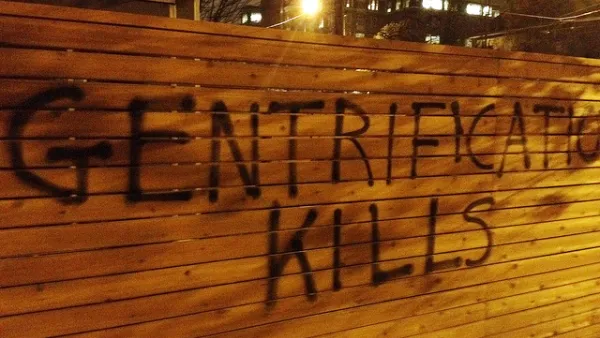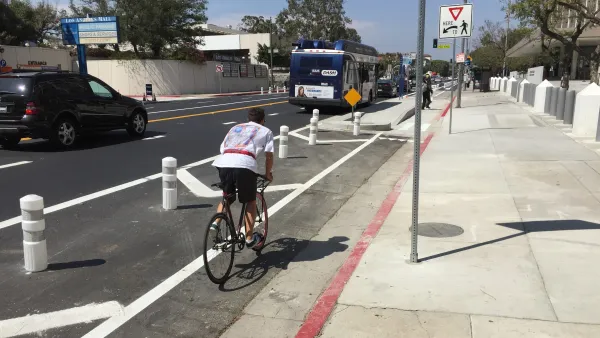Zócalo Public Square Editor Joe Mathews takes aim at the phrase, “We want to protect the character of the community," calling it a lousy argument in normal times and verging on "treasonous" due to climate change and California's housing crisis.

"The expressed desire to defend community character is a staple of California conversations," writes Mathews.
It’s routinely aimed at developers, planners or anyone with a big, transformational vision. But in a state struggling to keep up with changes in housing, economy and environment, there may be no more damaging set of words.
Planetizen has no tag for "community character," but has 22 posts tagged "neighborhood character." What's intriguing about Mathews' column is his observation that "protecting community character" is used by a wide array of interests.
The defense is most often, but not exclusively, expressed by homeowners and their groups to oppose housing projects that add unwanted density, even if not in their own single-family neighborhoods, as New York Times "Upshot" columnist Emily Badger reported last January (via Planetizen, "The Rise of the NIMBY Movement, and How Homeowners Came to Own the Whole Neighborhood"):
Common among these opposition campaigns is a conviction "that owning a parcel of land gives them a right to shape the world beyond its boundaries," according to Badger, who traces the roots of the idea that the influence of property owners should reach well beyond the property line.
It is also "used by poor people protesting gentrification that might bring richer people to their neighborhoods," observes Mathews, although he doesn't provide examples.
The proposed residential building moratorium in the gentrifying Mission District of San Francisco in 2015 comes to mind, meant to prevent displacement in the largely Latino neighborhood. Many residents want the moratorium campaign extended to bikeshare stations, which have "recently become a source of scorn from anti-gentrification advocates."
Mathews doesn't take on historical and cultural applications of protecting neighborhood character, although it's difficult to think why he would make them an exception.
Beyond housing
"As bad as today’s housing crisis is, it pales in comparison to the dangers that the community protection racket poses for California’s future," adds Mathews.
The threat of climate change, in particular, will require transformation in how and where we live, which by definition will change community character. And the state needs to invest on an enormous scale in transit so that we drive less and burn fewer fossil fuels. No responsible community in California should stay the same in such a time.
Proposition 13
For 40 years now, since the passage of Proposition 13, California has prioritized community stability — holding down property taxes to benefit existing homeowners and businesses — at the expense of schools, health care, business development and local services. It’s time for that era to end.
But that will require that we stop singing the praises of community character and start realizing that it’s really the anthem of California’s religion of obstruction.
Mathews began his passionate column by asking readers to adopt a New Year's resolution: "[F]or the good of your state, the best thing you could do is swear off this phrase: 'We want to protect the character of the community,'" and ends with:
And if your fellow Californians still persist in claiming they want to “protect the character of our community,” please feel free to start questioning their character.
FULL STORY: Resistance to development stands in way of prosperity

National Parks Layoffs Will Cause Communities to Lose Billions
Thousands of essential park workers were laid off this week, just before the busy spring break season.

Retro-silient?: America’s First “Eco-burb,” The Woodlands Turns 50
A master-planned community north of Houston offers lessons on green infrastructure and resilient design, but falls short of its founder’s lofty affordability and walkability goals.

Delivering for America Plan Will Downgrade Mail Service in at Least 49.5 Percent of Zip Codes
Republican and Democrat lawmakers criticize the plan for its disproportionate negative impact on rural communities.

Test News Post 1
This is a summary

Test News Headline 46
Test for the image on the front page.

Balancing Bombs and Butterflies: How the National Guard Protects a Rare Species
The National Guard at Fort Indiantown Gap uses GIS technology and land management strategies to balance military training with conservation efforts, ensuring the survival of the rare eastern regal fritillary butterfly.
Urban Design for Planners 1: Software Tools
This six-course series explores essential urban design concepts using open source software and equips planners with the tools they need to participate fully in the urban design process.
Planning for Universal Design
Learn the tools for implementing Universal Design in planning regulations.
EMC Planning Group, Inc.
Planetizen
Planetizen
Mpact (formerly Rail~Volution)
Great Falls Development Authority, Inc.
HUDs Office of Policy Development and Research
NYU Wagner Graduate School of Public Service





























